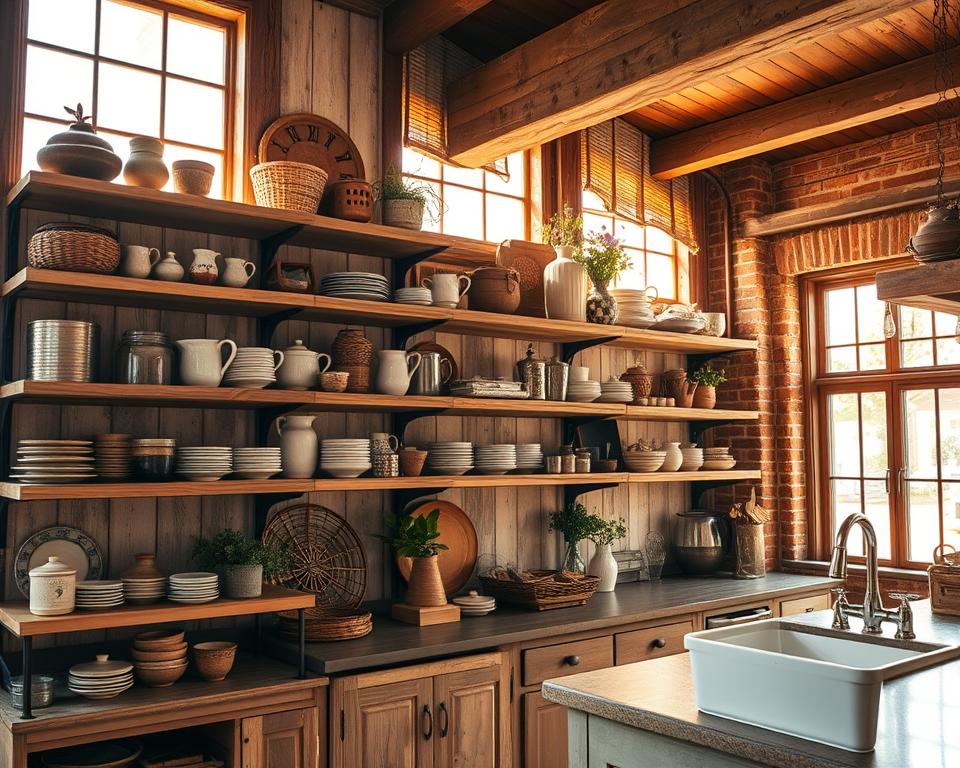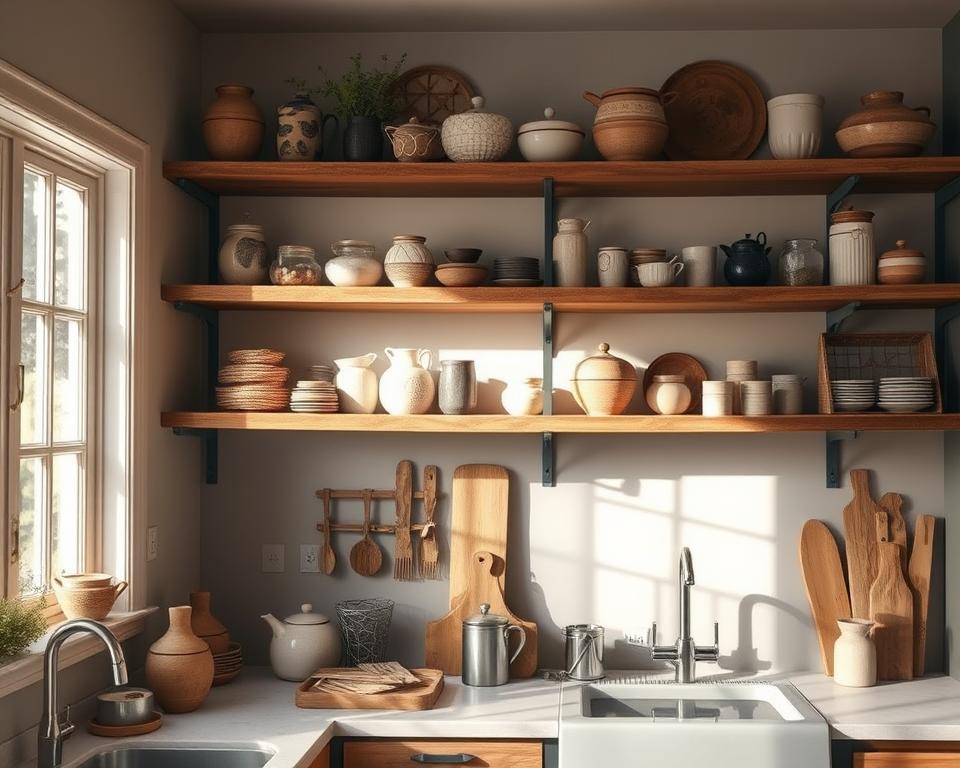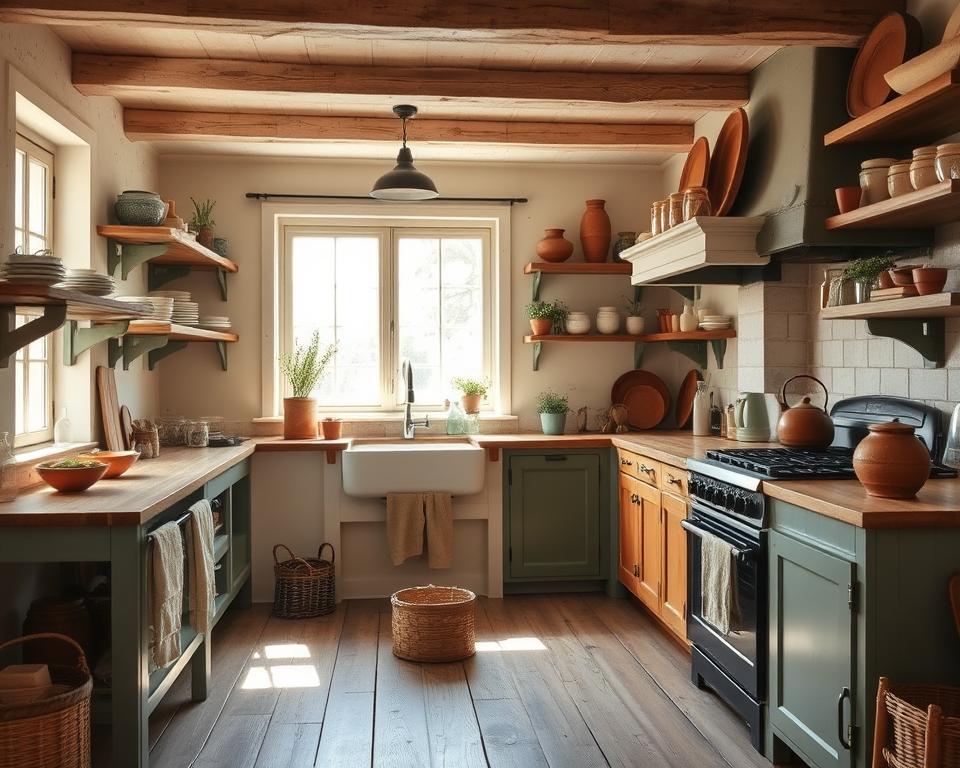Transform your kitchen into a warm, welcoming space with farmhouse kitchen charm. Open shelving offers both style and function, making smaller layouts feel airy while showcasing rustic kitchen decor. Designs often blend white subway tiles, shiplap walls, and reclaimed materials like cement tiles to create authentic character. Trends like apron-front sinks and beadboard paneling blend country kitchen inspiration with modern practicality.
Key Takeaways
- Open shelving replaces upper cabinets, adding light and space to farmhouse kitchens.
- White subway tiles and shiplap are classic elements for backsplashes and walls.
- Reclaimed wood and vintage accents like beaded-board panels enhance rustic authenticity.
- 75% of homeowners favor wide-plank floors, while 65% of designers use reclaimed materials for charm.
- Budget-friendly options like open shelves cost $50–$200 per foot, fitting various decor styles.
Understanding the Farmhouse Kitchen Aesthetic
The essence of farmhouse kitchen ideas is a blend of rustic charm and practicality. A vintage farmhouse kitchen is characterized by distressed wood and heirloom accents. These elements create spaces that are both timeless and lived-in. Let’s explore what makes this style so beloved.
Key Elements of Farmhouse Design
- Apron-front sinks anchor functional elegance
- Open shelving (used in 50% of designs) displays cherished dishware
- Exposed wood beams (80% adoption rate) emphasize natural architecture
Custom cabinetry often features cabinet skirts, with 15% of designs choosing this charming detail. The vintage farmhouse kitchen project showcased here used white oak cabinetry paired with a blue tile backsplash. This blend of tradition and modernity is striking.
Popular Color Schemes
Light palettes with neutrals like cream and pale blue are favored by 60% of designs. Muted accents such as sage green or dusty blue add warmth. A 20% minority introduces playful hues like soft coral or mustard for contrast. Wood tones, used in 35% of kitchens, bring warmth and depth through mixing multiple shades.
Materials and Textures
Butcher block countertops, affordable and durable, pair well with marble accents. 30% of kitchens use textured wood surfaces, while 40% blend gold accents for subtle modern contrast. Popular choices include:
- Distressed painted cabinetry (30% adoption)
- Antique mosaics or brick backsplashes
- Woven wicker baskets for storage
Remember: 60% of designers use vintage elements like baking pans as wall art. This adds to the rustic appeal.
| Material | Usage Percentage |
|---|---|
| Wood Beams | 80% |
| Marble Countertops | 40% |
| Cabinet Skirts | 15% |
Benefits of Open Shelving in the Kitchen
Open shelving is more than a fleeting trend; it’s a transformative element for farmhouse kitchens. It marries functionality with elegance, offering advantages that traditional cabinets can’t provide. From cost-effectiveness to visual appeal, open shelves are redefining kitchen spaces.
Studies show kitchens with open shelving feel up to 30% more spacious, transforming even small areas into airy hubs of activity.
Easy Access to Essential Items
- Open shelves cut down search time—dishes, spices, and tools are always in plain sight.
- Cutting costs by 50% compared to cabinetry makes this a budget-friendly upgrade for any farmhouse kitchen.
- 70% of users report faster cooking prep thanks to quick access to daily items.
Enhancing Kitchen Aesthetics
In modern farmhouse design, open shelving breaks up cabinetry monotony. The minimalist layout lets natural light bounce off shelves, creating a sunlit, inviting vibe. Rotating dishes and decor aligns with farmhouse style’s emphasis on lived-in warmth.
Creating an Inviting Atmosphere
Showcase cherished items like vintage mugs or pottery to turn your space into a personal gallery. 55% of homeowners highlight how displayed collections add character. The open layout invites guests to admire your style while maintaining a clutter-free look.
Choosing the Right Location for Open Shelving
Optimizing the appeal and utility of open shelving begins with thoughtful placement. Selecting the right spots enhances the farmhouse style while ensuring kitchen functionality. We will discuss how to select the ideal locations for your DIY farmhouse kitchen design.
Ideal Wall Spaces
Target walls near prep zones or dining areas for convenient access. Standard heights begin at 18 inches above countertops, with shelves spaced 12–18 inches apart. Follow these guidelines:
- Position the first shelf 18″ above countertops
- Ensure 6–12″ gaps between shelves
- Steer clear of high-traffic areas
Above Countertops vs. Walls
| Placement Option | Height Guidelines | Pros | Cons |
|---|---|---|---|
| Above Counters | 18″ from countertop | Easy access during cooking | Limited vertical space |
| Full-Wall Shelves | Align with 54″ cabinet standards | Showcases decor | Requires structural support |
Balancing with Other Storage Options
Integrate open shelving with farmhouse style cabinets for concealed storage. Use closed cabinets for pantry items or small appliances. For a DIY project, combine farmhouse cabinets with open shelves for a balanced look. Tip: Organize similar items together—display mason jars and cookbooks on open shelves, while keeping dishes in cabinets below.
Regular upkeep ensures your displays remain fresh. Rotate decor seasonally and clean weekly to preserve the rustic charm without clutter. With meticulous planning, your DIY farmhouse kitchen will seamlessly merge style and functionality.
Selecting the Perfect Shelving Material
When selecting materials for your farmhouse kitchen shelves, it’s crucial to find a balance between style and function. Rustic kitchen decor excels with natural textures, while modern farmhouse design combines simplicity with durability. Here’s a guide to help you choose the right material:
Wood Options for Farmhouse Style
Solid wood is a timeless choice. Reclaimed oak or pine brings warmth, while painted finishes offer a crisp modern farmhouse design. Here are some popular options:
- Reclaimed Wood: Its distressed surfaces and visible grain instantly add rustic charm.
- Painted Pine: White or light finishes brighten small kitchens and complement minimalist accents.
- Walnut: Dark tones elevate sophistication in larger kitchens.
Metal Shelving: Pros and Cons
Industrial metals like iron or steel are durable. They work well in kitchens with rustic kitchen decor or transitional styles:
- Pros: They can hold heavy items (up to 50 lbs/ft), resist moisture, and complement metal accents.
- Cons: They may need protective coatings in humid areas.
Composite and Other Materials
Composite boards resist warping and are perfect for high-moisture zones. Glass shelves add brightness but require careful cleaning. Here’s a comparison:
| Material | Best Use | Maintenance |
|---|---|---|
| Wood | Displays dishes and decor | Season annually; wipe spills immediately |
| Metal | Heavy-duty storage | Polish monthly to prevent rust |
| Composite | Moisture-prone areas | Simple soap-and-water cleaning |
Match your material choices with your kitchen’s layout. Reclaimed wood shelves (10-12 inches deep) are ideal for rustic kitchen decor. Metal brackets add industrial contrast. Your style should guide your selection, whether you prefer cozy farmhouse charm or sleek modern touches.
Styling Your Open Shelves
Transform your farmhouse kitchen into a showcase of rustic charm by styling shelves with intention. Mix practical items and decorative accents to balance beauty and function. Here’s how to turn empty shelves into focal points that reflect your personal style.
Displaying Dishware Creatively
Stack plates vertically or lean bowls against walls to add texture. Group similar items in clusters, like mason jars or colorful mugs, for a curated look. Layering mismatched plates creates depth without overcrowding. Opt for matte-finish ceramics or glazed pottery to align with rustic kitchen decor trends.
Adding Greenery and Decor
Place small potted herbs or succulents between kitchen tools to blend nature with utility. Use galvanized metal planters for a farmhouse kitchen ideas vibe. Add woven baskets or woven grass trays to hold spices or utensils. For bold pops of color, choose ceramic vases or hand-painted serveware from thrift stores.
Cohesive Styling Techniques
Follow the “rule of three” when arranging items—group objects in odd-numbered sets for visual harmony. Vary heights with items like cake stands or tiered trays.
“Balance is key. Let one bold piece anchor the shelf, then fill gaps with smaller accents,”
says interior designer Emily Henderson. Use these tips in your setup:
- Alternate between functional items (cookbooks, utensils holders) and decor (ceramic figurines, dried flowers)
- Align shelf edges with countertop heights for a seamless flow
- Paint shelves to match cabinetry for a cohesive look
| Tip | Example |
|---|---|
| Scale Contrast | Pair a large pottery bowl with tiny salt shakers |
| Texture Mix | Combine woven baskets with smooth ceramic jugs |
| Color Palette | Stick to 3 shades (e.g., cream, terracotta, sage green) |
Organizing Essentials on Open Shelves
Open shelving in a farmhouse kitchen relies on thoughtful organization. Organizing items by use and visibility ensures both functionality and style. Begin by grouping essential tools near your workstations—such as mixing bowls, spices, or coffee supplies. For instance, a vintage hutch can hold your daily dishes, while pantry shelves categorize grains, sauces, and baking supplies.
- Tip: Reserve higher or deeper spots for less frequently used items, keeping frequently accessed items like mugs or pots at eye level.
Storage baskets and crates bring rustic charm and help manage clutter. Woven baskets can hold small items like utensils or lids, while open wooden crates showcase seasonal decor. Choose natural materials that complement country kitchen inspiration—like willow, rattan, or reclaimed wood. A pro tip is to store glasses upside down to prevent dust accumulation, a common practice in commercial kitchens.
Prevent overcrowding by being selective. Make the most of vertical space, such as stacking plates at an angle or leaning recipe boxes against walls. Rotate seasonal items—switch out holiday decor for fresh herbs in spring. Remember, maintaining open shelving requires effort, but it rewards you with a kitchen that feels both lived-in and curated. As one designer notes:
“A well-organized shelf is a silent storyteller of your lifestyle.”
Keep a balance by leaving some space empty. A minimalist approach with a few decorative pieces prevents visual overload. Focus on items that reflect your cooking habits and style, ensuring each piece has its place in your farmhouse kitchen sanctuary.
Adding Functional Items to Your Shelving
Open shelves in farmhouse kitchens are best when items serve more than one purpose. Over 60% of homeowners blend functionality with style here, showing that practicality doesn’t mean losing charm. This space is perfect for showcasing tools that are as useful as they are visually appealing.
Begin with cookbooks displayed in a vintage ladder rack or a DIY project like a repurposed ladder. Frame your favorite recipes in rustic frames or store them in woven baskets for both accessibility and style. Recipe boxes made from reclaimed wood bring warmth and protect the pages.
Cookbooks and Recipe Holders
- Display heirloom cookbooks in leather-bound covers for instant farmhouse flair.
- Use clear acrylic boxes to organize recipe cards while keeping them visible.
- Hang a chalkboard above shelves to jot down daily meal plans.
Frequently Used Utensils
Choose utensils that complement your kitchen’s style. Wooden spoons with carved handles or copper colanders add rustic charm. A study shows 50% less time searching when tools are on open shelves. Pair modern gadgets like stand mixers with retro canisters for a striking contrast.
Decorative yet Practical Items
| Item | Function | Aesthetic Role |
|---|---|---|
| Earthenware jugs | Store spices or oils | Add earthy texture |
| Burlap sacks | Hold utensils or herbs | Bring rustic texture |
| Iron pot racks | Display cookware | Create industrial accents |
Mix in farmhouse kitchen ideas like hanging a copper kettle or stacking mason jars with fresh herbs. Choose items that tell your story, like a cast-iron skillet passed down through generations. Rotate seasonal decor like harvest pumpkins or citrus arrangements to keep the look fresh. Every item should be as functional as it is beautiful, ensuring your shelves remain both useful and inspiring.
Lighting Considerations for a Farmhouse Kitchen
Thoughtful lighting can turn a farmhouse kitchen into a warm and inviting space. Whether you’re planning a farmhouse kitchen renovation or just updating fixtures, the right choices enhance rustic charm. They also ensure the space remains bright and welcoming.
Natural Light and Its Impact
To avoid dark corners, maximize sunlight. Large windows with sheer curtains allow natural light to enter without glare. Mirrors placed opposite windows can bounce light, making smaller spaces appear brighter. In many farmhouse kitchens, mirrors also create the illusion of higher ceilings.
During a farmhouse kitchen renovation, consider adding skylights or transom windows over cabinets. These can bring in extra daylight, enhancing the overall brightness of the space.
Choosing Light Fixtures
Blend practicality with style by selecting fixtures that complement your modern farmhouse design. Here are some suggestions:
- Pendant lights: Hang 2-3 feet above kitchen islands for task lighting.
- LED under-cabinet strips: Perfect for prep areas, these keep counters well-lit without shadows.
- Rustic chandeliers or clear-glass pendants: Combine vintage details with sleek metals for a modern farmhouse design vibe.
Dimmable fixtures allow you to adjust the brightness for different occasions, whether it’s meals or gatherings.
Ambience with Accent Lighting
Layer light sources to create the perfect mood. Combine overhead fixtures with:
- Wall sconces with candle-style bulbs
- Table lamps in earthy tones
- Warm-toned string lights along open shelving
Plan your lighting early in the renovation to avoid electrical issues. Use pendants over eating areas for visual impact. Pair them with neutral-toned bulbs to highlight wood tones and decor.
Personal Touches to Bring Warmth
Transform your open shelves into a gallery of personal stories. A vintage farmhouse kitchen thrives on items that carry history—think your grandmother’s porcelain teacups or a cast-iron skillet passed down through generations. These pieces add authenticity beyond current farmhouse kitchen trends.
“The best farmhouse spaces tell a story, not just follow rules.” – Emily Carter, Interior Designer
Family Heirlooms as Decor
Rotate heirlooms seasonally to keep displays fresh. For example, place a carved wooden butter dish during holidays or display antique canning jars year-round. Mix with modern pieces like copper pots to bridge past and present styles.
Crafting Homemade Items
Add handmade touches with simple projects:
- Paint mason jars with floral designs
- Weave burlap coasters
- Create recipe cards in a rustic frame
These items blend seamlessly into avintage farmhouse kitchenwhile showcasing your creativity.
Seasonal Decor Ideas
| Season | Key Elements |
|---|---|
| Spring | Bouquets of daffodils + pastel dish towels |
| Summer | Cut lemons + woven seagrass baskets |
| Winter | Pinecones + cinnamon sticks in mason jars |
Pair seasonal items with a neutral base of white dishes and natural wood to avoid over-the-top transitions. Let your shelves evolve with your life’s milestones—a framed photo of a family reunion or a child’s hand-painted plate—making your kitchen a living scrapbook of memories.
Maintenance Tips for Open Shelving
Keeping your farmhouse kitchen’s open shelving in top shape is crucial. It ensures both functionality and beauty. Regular maintenance is essential to prevent clutter and protect your investment. Here are some tips to make upkeep simple:
Cleaning and Dusting Strategies
- Weekly dusting can reduce buildup by 80%—opt for a microfiber cloth on wood or metal.
- Apply beeswax polish to wooden shelves monthly to repel water and stains.
- Quick daily wipes after cooking can prevent grease from setting in.
Preventing Damage to Items
Protect your farmhouse kitchen’s decor with these steps:
- Use clear silicone liners under ceramics to guard against spills.
- Rotate delicate items like vintage dishes into closed storage during busy seasons.
- Avoid placing items in direct sunlight to prevent fading or warping.
Rotating Displayed Items
Refresh your space without effort:
- Swap seasonal decor every 3-4 months to avoid stagnation.
- Store unused dishes in cabinets during off-seasons to reduce cleaning load.
- Pair new purchases with old favorites to keep displays lively yet consistent.
Set aside 10-15 minutes weekly for upkeep. This ensures your farmhouse kitchen remains stunning without overwhelming your schedule. Small, consistent efforts will keep your open shelving a standout feature for years.
Integrating Farmhouse Kitchen Trends
Combining modern touches with rustic charm keeps farmhouse kitchens vibrant. Today’s country kitchen inspiration spans from classic Americana to global styles. This blend creates spaces that are both nostalgic and contemporary.
Combine sleek quartz countertops with reclaimed wood accents for a unique look. Choose brass hardware for traditional open shelving or smart storage like wireless charging drawers. Deslaurier’s custom cabinetry shows how tradition and technology can harmonize, pairing farmhouse sinks with minimalist designs.
- Modern Farmhouse: White cabinets with subway tiles, like Beauflor’s Oterra collection, bring a clean aesthetic.
- Industrial Farmhouse: Exposed brick walls meet marble countertops, seen in Metroflor’s Deja New flooring, for a contrasting look.
- French Country: Beadboard ceilings and copper pots evoke European rustic elegance.
- Coastal Farmhouse: Light blues and wicker baskets capture seaside charm.
Start with neutral bases like soft whites or green cabinets. Update decor with baskets or plants to refresh the space without major expenses. Use bold colors sparingly, focusing on accent pieces like copper pots or patterned dishware.
Tip: Seasonally update open shelves. Hang wreaths in winter or terracotta pots in spring. This keeps the space fresh without losing its farmhouse essence.
Final Thoughts on Your Farmhouse Kitchen Journey
Turning a kitchen into a farmhouse oasis with open shelving is more than a renovation. It’s a celebration of history and personal expression. For those restoring a century-old home, like the 1893 farmhouse, this journey takes time. It often spans years, but the end result is a space that blends tradition with modern comfort. Whether your project takes four years or just a few months, every choice makes the room feel authentically yours.
Embracing Your Personal Style
Your space should reflect your story, just like Laura Ingalls Wilder’s iconic kitchen. Farmhouse kitchen ideas thrive on mixing heirlooms with practical touches. A century-old pantry cabinet or handcrafted decor can add character. Let inspiration from road trips or family traditions guide your choices. Ensure every shelf and color—whether soft white or muted blue—speaks to your life.
Enjoying the Process
Renaissance projects, like the 125-year-old farmhouse’s kitchen overhaul, are journeys filled with learning. Even with 11 blog posts and a 3-week road trip’s inspiration, patience is key. Prioritize tasks like preserving original wood or installing a new pantry. Remember, no professional expertise is needed. Each step, from cleaning 7 layers of linoleum to balancing wood and metal, becomes part of your kitchen’s narrative.
Welcoming Friends and Family
A well-designed farmhouse kitchen isn’t just functional—it’s a gathering place. Open shelves display cherished items, while a restored 9×14-foot space invites conversation. Whether hosting a holiday feast or a quiet meal, your kitchen should feel alive. By thoughtfully arranging dishes, adding greenery, or keeping the 1900 barn’s rustic elements in mind, you create a home where memories form naturally.
FAQ
What are the key elements of a farmhouse kitchen design?
How can open shelving benefit my kitchen?
Where is the best place to install open shelving in my kitchen?
What materials should I consider for open shelving?
How do I style my open shelves to achieve a farmhouse look?
What are effective organization tips for open shelving?
How can I add functional items to my open shelving?
What lighting considerations should I keep in mind for my farmhouse kitchen?
How can I infuse personal touches into my kitchen design?
What maintenance tips should I follow for open shelving?
How do I stay updated with farmhouse kitchen trends without compromising longevity?

Tina Moore is a writer at TrendGaping, dedicated to farmhouse decor and rustic minimalism. With a love for natural textures and vintage charm, she explores topics like distressed wood finishes, cozy interiors, and functional yet stylish design. Her goal is to help readers create warm, inviting spaces that reflect the beauty of country living.



